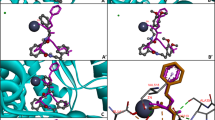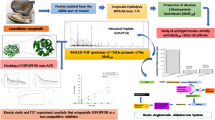Abstract
We have previously reported that the proline-rich decapeptide from Bothrops jararaca (Bj-PRO-10c) causes potent and sustained antihypertensive and bradycardic effects in SHR. These activities are independent of ACE inhibition. In the present study, we used the Ala-scan approach to evaluate the importance of each amino acid within the sequence of Bj-PRO-10c (Pyr1-Asn2-Trp3-Pro4-His5-Pro6-Gln7-Ile8-Pro9-Pro10). The antihypertensive and bradycardic effects of the analogues Bj-PRO-10c Ala3, Bj-PRO-10c Ala7, Bj-PRO-10c Ala8 were similar to those of Bj-PRO-10c, whereas the analogues Bj-PRO-10c Ala2, Bj-PRO-10c Ala4, Bj-PRO-10c Ala5, Bj-PRO-10c Ala9, and Bj-PRO-10c Ala10 kept the antihypertensive activity and lost bradycardic activity considerably. In contrast, Bj-PRO-10c Ala1 and Bj-PRO-10c Ala6 were unable to provoke any cardiovascular activity. In summary, we demonstrated that (1) the Pyr1 and Pro6 residues are essential for both, the antihypertensive and bradycardic effects of Bj-PRO-10c; (2) Ala-scan approach allowed dissociating blood pressure reduction and bradycardic effects. Conformational properties of the peptides were examined by means of circular dichroism (CD) spectroscopy. The different Ala-scan analogues caused either an increase or decrease in the type II polyproline helix content compared to Bj-PRO-10c. The complete loss of activity of the Pro6 → Ala6 mutant is probably due to the fact that in the parent peptide the His5-Pro6 bond can exist in the cis configuration, which could correspond to the conformation of this bond in the bound state. Current data support the Bj-PRO-10c as a promising leader prototype to develop new agents to treat cardiovascular diseases and its co-morbidities.






Similar content being viewed by others
Abbreviations
- ACE:
-
Angiotensin-I converting enzyme
- Ala-scan:
-
Alanine scan
- AsS:
-
Argininosuccinate synthetase
- Bj :
-
Bothrops jararaca
- Bj-PRO:
-
Bothrops jararaca-proline-rich oligopeptides
- CD:
-
Circular dichroism
- HR:
-
Heart rate
- i.v.:
-
Intravenous
- MAP:
-
Mean arterial pressure
- MDLA:
-
Alpha-methyl-dl-aspartic acid
- NO:
-
Nitric oxide
- PAP:
-
Pulsatile arterial pressure
- Pyr:
-
Pyroglutamic acid
- SHR:
-
Spontaneously hypertensive rat
References
Alana I, Parker JC, Gault VA, Flatt PR, O’Harte FP, Malthouse JP, Hewage CM (2006) NMR and alanine scan studies of glucose-dependent insulinotropic polypeptide in water. J Biol Chem 281(24):16370–16376
Biedermannova L, ER K, Berka K, Hobza P, Vondrasek J (2008) Another role of proline: stabilization interactions in proteins and protein complexes concerning proline and tryptophane. Phys Chem Chem Phys 10(42):6350–6359
Bunag RD, Walaszek EJ, Mueting N (1975) Sex differences in reflex tachycardia induced by hypotensive drugs in unanesthetized rats. Am J Physiol 229(3):652–656
Camargo AC, Fernandes BL, Cruz L, Ferro ES (2012a) Bioactive peptides produced by limited proteolysis. Morgan & Claypool publishers. doi:10.4199/C00056ED1V01Y201204NPE002
Camargo AC, Ianzer D, Guerreiro JR, Serrano SM (2012b) Bradykinin-potentiating peptides: beyond captopril. Toxicon 59(4):516–523
Carmona AK, Juliano L (1996) Inhibition of angiotensin converting enzyme and potentiation of bradykinin by retro-inverso analogues of short peptides and sequences related to angiotensin I and bradykinin. Biochem Pharmacol 51(8):1051–1060
Corzo G, Sabo JK, Bosmans F, Billen B, Villegas E, Tytgat J, Norton RS (2007) Solution structure and alanine scan of a spider toxin that affects the activation of mammalian voltage-gated sodium channels. J Biol Chem 282(7):4643–4652
Cunningham BC, Wells JA (1989) High-resolution epitope mapping of hGH-receptor interactions by alanine-scanning mutagenesis. Science 244(4908):1081–1085
Cushman DW, Pluscec J, Williams NJ, Weaver ER, Sabo EF, Kocy O, Cheung HS, Ondetti MA (1973) Inhibition of angiotensin-coverting enzyme by analogs of peptides from Bothrops jararaca venom. Experientia 29(8):1032–1035
De Sousa FB, Denadai AML, Lula IS, Ianzer D, Malaspina ER, Camargo ACM, Santos RAS, Sinisterra RD (2010) Structural and physical–chemical evaluation of bradykinin potentiating peptide and its high soluble supramolecular complex. J Incl Phenom Macrocycl Chem 67:407–422
Flam BR, Hartmann PJ, Harrell-Booth M, Solomonson LP, Eichler DC (2001) Caveolar localization of arginine regeneration enzymes, argininosuccinate synthase, and lyase, with endothelial nitric oxide synthase. Nitric Oxide 5(2):187–197
Goldberg M, Gomez-Orellana I (2003) Challenges for the oral delivery of macromolecules. Nat Rev Drug Discov 2(4):289–295
Guerreiro JR, Lameu C, Oliveira EF, Klitzke CF, Melo RL, Linares E, Augusto O, Fox JW, Lebrun I, Serrano SM, Camargo AC (2009) Argininosuccinate synthetase is a functional target for a snake venom anti-hypertensive peptide: role in arginine and nitric oxide production. J Biol Chem 284(30):20022–20033
Gund P (1977) Three-dimensional pharmacophoric pattern searching. In: progress in molecular and subcellular biology, vol 5. pp 117–143
Hayashi MA, Murbach AF, Ianzer D, Portaro FC, Prezoto BC, Fernandes BL, Silveira PF, Silva CA, Pires RS, Britto LR, Dive V, Camargo AC (2003) The C-type natriuretic peptide precursor of snake brain contains highly specific inhibitors of the angiotensin-converting enzyme. J Neurochem 85(4):969–977
Ianzer D, Konno K, Marques-Porto R, Vieira Portaro FC, Stocklin R, Martins de Camargo AC, Pimenta DC (2004) Identification of five new bradykinin potentiating peptides (BPPs) from Bothrops jararaca crude venom by using electrospray ionization tandem mass spectrometry after a two-step liquid chromatography. Peptides 25(7):1085–1092
Ianzer D, Santos RA, Etelvino GM, Xavier CH, de Almeida, Santos J, Mendes EP, Machado LT, Prezoto BC, Dive V, de Camargo AC (2007) Do the cardiovascular effects of angiotensin-converting enzyme (ACE) I involve ACE-independent mechanisms? new insights from proline-rich peptides of Bothrops jararaca. J Pharmacol Exp Ther 322(2):795–805
Ianzer DA, Bernardes I, Lima AM, Santos RAS, Xavier CH, Fontes MAP (2010) BPP-10c from Bothrops jararaca venom changes behavioral and cardiovascular responses to acute stress exposure. FASEB J 24(811):814
Ianzer D, Xavier CH, Fraga FC, Lautner RQ, Guerreiro JR, Machado LT, Mendes EP, de Camargo AC, Santos RA (2011) BPP-5a produces a potent and long-lasting NO-dependent antihypertensive effect. Ther Adv Cardiovasc Dis 5(6):281–295
Isaac RE, Bland ND, Shirras AD (2009) Neuropeptidases and the metabolic inactivation of insect neuropeptides. Gen Comp Endocrinol 162(1):8–17
Kelly MA, Chellgren BW, Rucker AL, Troutman JM, Fried MG, Miller AF, Creamer TP (2001) Host-guest study of left-handed polyproline II helix formation. Biochemistry 40(48):14376–14383
Lee HJ, Zheng JJ (2010) PDZ domains and their binding partners: structure, specificity, and modification. Cell Commun Signal 8:8. doi:10.1186/1478-811X-8-8
Machado RS, Guest JR, Williamson MP (1993) Mobility in pyruvate dehydrogenase complexes with multiple lipoyl domains. FEBS Lett 323(3):243–246
Marlborough DI, Fisher GH, Ryan JW (1981) Circular dichroism spectra of some lower homologs of bradykinin potentiating peptide 9 alpha. Arch Biochem Biophys 210(1):43–48
Meng HY, Thomas KM, Lee AE, Zondlo NJ (2006) Effects of i and i + 3 residue identity on cis-trans isomerism of the aromatic(i + 1)-prolyl(i + 2) amide bond: implications for type VI beta-turn formation. Biopolymers 84(2):192–204
Moradi M, Babin V, Roland C, Sagui C (2010) A classical molecular dynamics investigation of the free energy and structure of short polyproline conformers. J Chem Phys 133(12):125104
Murayama N, Hayashi MA, Ohi H, Ferreira LA, Hermann VV, Saito H, Fujita Y, Higuchi S, Fernandes BL, Yamane T, de Camargo AC (1997) Cloning and sequence analysis of a Bothrops jararaca cDNA encoding a precursor of seven bradykinin-potentiating peptides and a C-type natriuretic peptide. Proc Natl Acad Sci USA 94(4):1189–1193
Neduva V, Russell RB (2006) Peptides mediating interaction networks: new leads at last. Curr Opin Biotechnol 17(5):465–471
Quartara L, Ricci R, Meini S, Patacchini R, Giolitti A, Amadesi S, Rizzi C, Rizzi A, Varani K, Borea PA, Maggi CA, Regoli D (2000) Ala scan analogues of HOE 140. Synthesis and biological activities. Eur J Med Chem 35(11):1001–1010
Rucker AL, Pager CT, Campbell MN, Qualls JE, Creamer TP (2003) Host-guest scale of left-handed polyproline II helix formation. Proteins 53(1):68–75
Shen LJ, Beloussow K, Shen WC (2005) Accessibility of endothelial and inducible nitric oxide synthase to the intracellular citrulline–arginine regeneration pathway. Biochem Pharmacol 69(1):97–104
Silva CA, Ianzer DA, Portaro FC, Konno K, Faria M, Fernandes BL, Camargo AC (2008a) Characterization of urinary metabolites from four synthetic bradykinin potentiating peptides (BPPs) in mice. Toxicon 52(3):501–507
Silva CA, Portaro FC, Fernandes BL, Ianzer DA, Guerreiro JR, Gomes CL, Konno K, Serrano SM, Nascimento N, Camargo AC (2008b) Tissue distribution in mice of BPP 10c, a potent proline-rich anti-hypertensive peptide of Bothrops jararaca. Toxicon 51(4):515–523
Thomas KM, Naduthambi D, Zondlo NJ (2006) Electronic control of amide cis–trans isomerism via the aromatic-prolyl interaction. J Am Chem Soc 128(7):2216–2217
Uekama K, Hirayama F, Irie T (1998) Cyclodextrin drug carrier systems. Chem Rev 98(5):2045–2076
Zelanis A, Tashima AK, Rocha MM, Furtado MF, Camargo AC, Ho PL, Serrano SM (2010) Analysis of the ontogenetic variation in the venom proteome/peptidome of Bothrops jararaca reveals different strategies to deal with prey. J Proteome Res 9(5):2278–2291
Acknowledgments
The majority of the in vivo study was used as part of the requirements for a master’s degree by J.F.B. Paschoal. This research was supported by Grants provided by Fundação de Amparo à Pesquisa do Estado de São Paulo (CAT/Cepid-FAPESP, 98/14307-9), Conselho Nacional de Desenvolvimento Científico e Tecnológico (CNPq) and Coordenação de Aperfeiçoamento de Pessoal de Nível Superior (CAPES), Edital Toxinologia—n. 63/2010, AUXPE 1593/2011. G.P.B.C. is recipient of CNPq PhD fellowship. S.S. is recipient of CNPq research fellowship. The authors would like to acknowledge Beatriz L. Fernandes for critical review, Maria José da Silva and Isaías França da Silva for secretarial assistance, and Vera Pontieri for technical assistance.
Confict of interest
The authors declare that they have no conflict of interest.
Author Contributions
Participated in research design: A.C.M. Camargo and D. Ianzer;
Conducted experiments: J.F.B. Paschoal, J. Yamaguchi, J.R.R. Miranda, C.H. Xavier, G. Carretero and D. Ianzer;
Contributed new reagents or analytic tools: R.L. Melo, R.A.S. Santos and S. Schreier;
Performed data analysis: D. Ianzer, C.H. Xavier, G. Carretero and S. Schreier;
Wrote or contributed to the writing of the manuscript: C.H. Xavier, G. Carretero, S. Schreier, A.C.M. Camargo, and D. Ianzer.
Author information
Authors and Affiliations
Corresponding author
Additional information
J. F. B. Paschoal and J. Yamaguchi should be considered as co-first authors.
Electronic supplementary material
Below is the link to the electronic supplementary material.
Rights and permissions
About this article
Cite this article
Paschoal, J.F.B., Yamaguchi, J., Miranda, J.R.R. et al. Insights into cardiovascular effects of proline-rich oligopeptide (Bj-PRO-10c) revealed by structure–activity analyses: dissociation of antihypertensive and bradycardic effects. Amino Acids 46, 401–413 (2014). https://doi.org/10.1007/s00726-013-1630-x
Received:
Accepted:
Published:
Issue Date:
DOI: https://doi.org/10.1007/s00726-013-1630-x




